If you're ever seen an indigo milkcap, you've probably wondered what you can do to keep the color blue after cooking. Pickling is one of the oldest ways to do that.
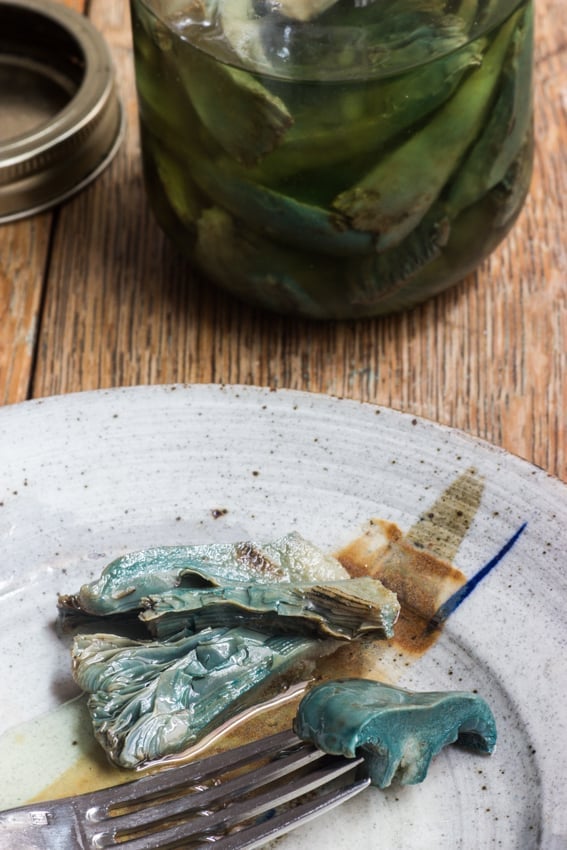
Delicious blue mushrooms! Sounds like a joke or a drug, right? Indigo milkcaps a.k.a lactarius indigo are pretty cool. They're one of the only blue foods that you can eat that I know of, with the exception of a couple berries and potatoes.
I can still remember the first time I found one, baffled by the vibrant blue. Most of the indigos I found at first were huge and bug damaged, but over the past few years I’ve been able to get some nice, unspoiled ones if the stars, and the rain align.
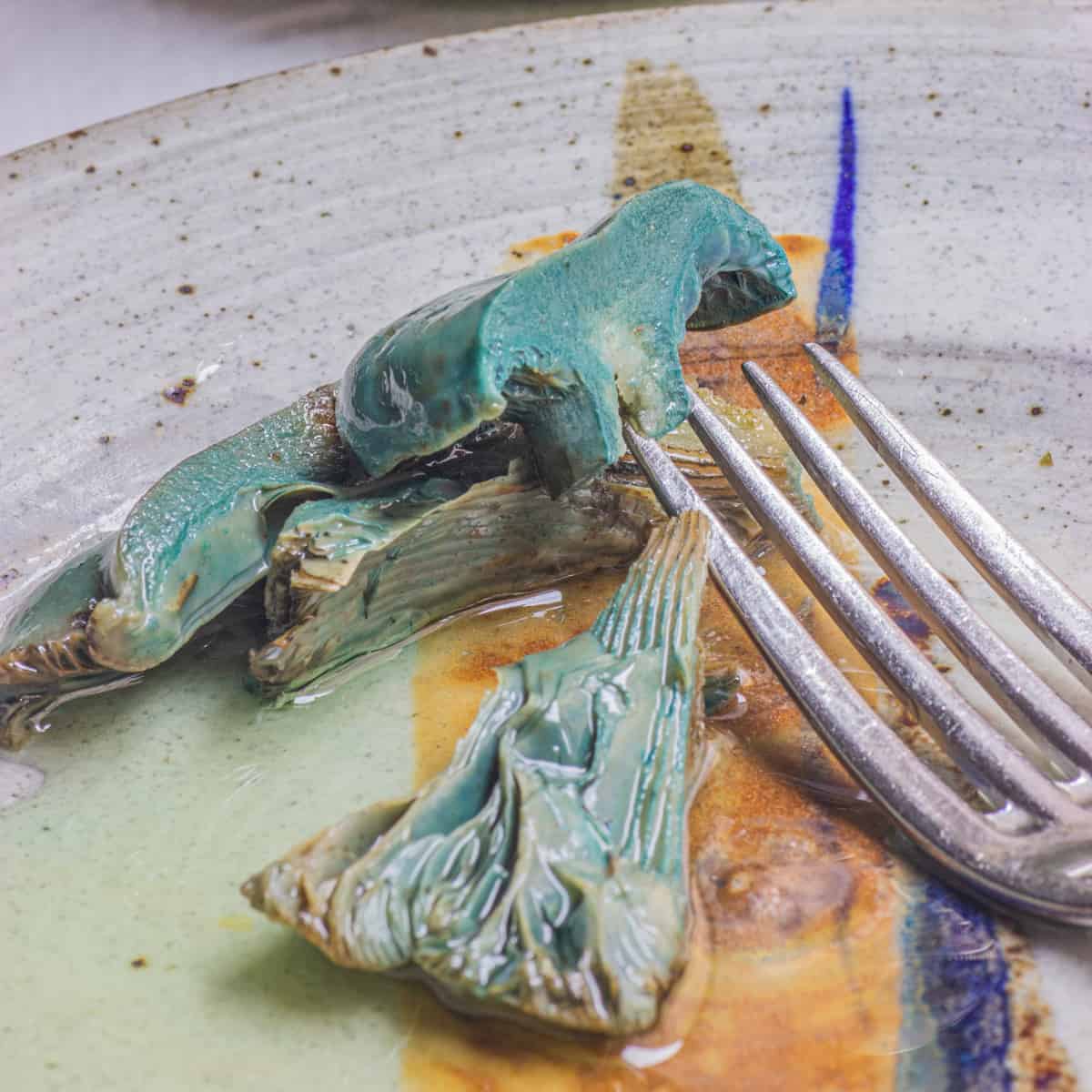
The first time I ate them I was a little disappointed though, the mushrooms cooked up good enough, but they turned brown after being sautéed in a pan. I kind of gave up on ever being able to preserve the color of the blue mushrooms, that is until I saw a jar of pickled mushrooms on a Russian recipe website (I forget which one).
There was a mix of different mushrooms in the jar of pickles, but here and there I spotted long streaks of blue, then it hit me about the simplicity of why the mushrooms lost their blue color.
Citric Acid or Vinegar: The Key to Keeping Your Lactarius Blue
Here was my "aha" thought: browning something in a pan is going to do just that. The reaction to fat and a pan is what robs the mushroom of it’s blue color. Cooking the mushrooms in a wet method, where they don’t have dry contact with a pan, will preserve it’s color. Considering that you might want to just pickle them, but not so fast-there’s a catch.
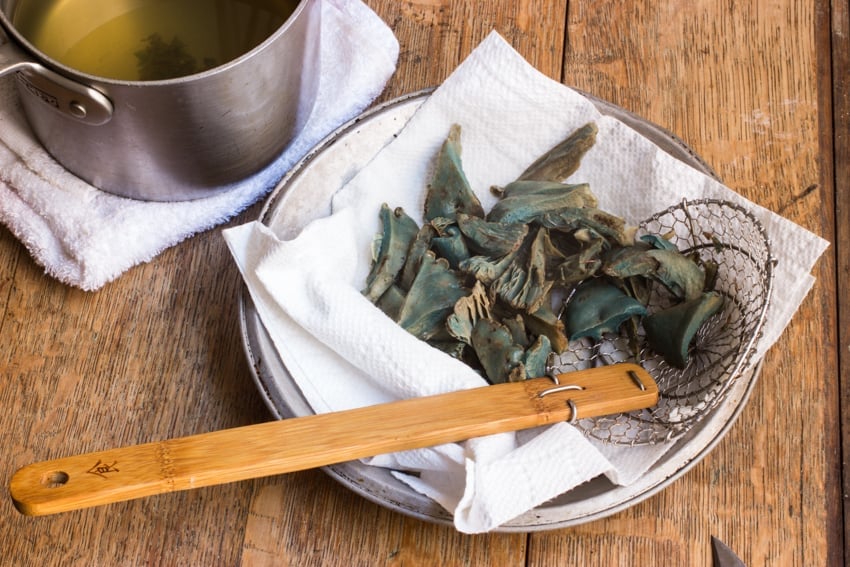
The caveat to cooking lactarius and preserving in jars, from my experience, is that the mushrooms develop a sort of mucilage, which makes them pretty slimy when preserved in their own juice and stuffed tightly in a jar. Honey mushrooms and amanitas do this too, and I’ve found give off much more of the stuff than lactarius, but it’s still there nonetheless.
In a nutshell, I wanted to preserve lactarius indigo in a tasty way, and keep it’s blue color, but I also didn’t want it to be slimy. After a couple experiments I got the result I wanted.
Here's what you do. You take your lactarius and blanch them in a seasoned pickling liquid, which also acts as a preservative. From there, you drain the mushrooms thoroughly and then pack in some flavored oil. The preliminary blanching leaches away the snot effect, but it also functions as a way to impart flavor, as well as lower the ph for their stasis in the fridge.
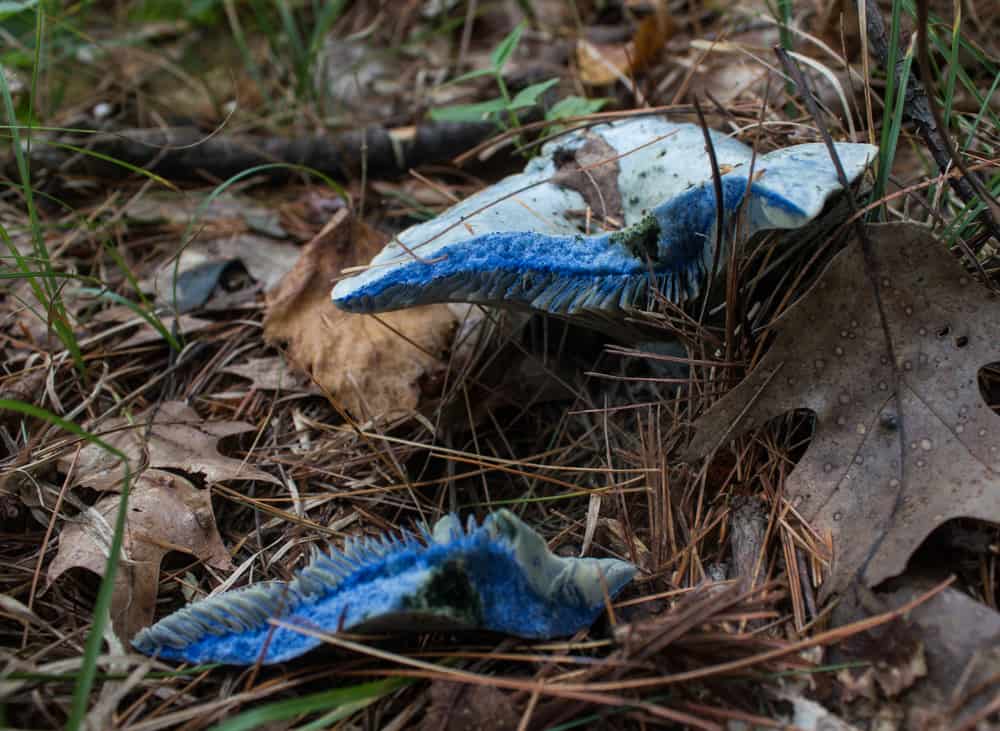
Olio Santo (Herb Oil)
The olio santo here is something I adapted from one of the greats of Italian cooking: Guiliano Bugialli, and I've been using variations of it for years. It’s a great way to flavor oil without having chunks of aggressive things in it like garlic.
It’s a great, simple recipe, perfect for garnishing grilled meats or vegetables, or perfuming something that will be around for a while, like these blue mushrooms. In Italian Olio Santo translates to "holy oil", which I always thought was fun, I remember telling employees at a couple different restaurants I was "anointing" things with it. 🙂
These are a lot of fun, and great as a little snack. I'll mention too: it's a total misnomer that mushrooms pickles should be eaten cold, quite the contrary. One of my favorite ways to eat pickled or preserved shrooms is warm in the morning with some eggs or with toast, the crunch is an awesome foil for the chew of the mushrooms. Next time you find some indigo milkcaps, give it a try.

Indigo Milkcaps Preserved In Herb Oil
Equipment
- 1 4 quart sauce pot
- 2 wide mouth pint mason jars
Ingredients
- 2 lb lb indigo milkcaps cleaned and sliced ½ in
- 2 qts water
- 1 qt apple cider vinegar or white vinegar in a pinch
- 2 tablespoon kosher salt
Herb Oil (Olio Santo)
- ½ cup EVOO
- ½ cup flavorless cooking oil like canola or grapeseed
- 2 dried or fresh bay leaves
- 1 tsp crushed red pepper flakes
- 3 cloves Garlic crushed with the back of a knife
- 1 sprig fresh rosemary
- 1 lemon Zest peeled off into strips
Instructions
Herb Oil
- Combine all the ingredients in a small sauce 1 qt sauce pan and heat the mixture until hot but not boiling, and the garlic begins to sizzle, then remove the pan from the heat and allow to cool and infuse overnight for the best flavor.
- After the oil has infused, strain and reserve it until needed. The flavor will keep better under refrigeration.
Mushrooms
- Bring the water, salt, and vinegar to a boil.
- Add the mushrooms and simmer until wilted and thoroughly cooked, about 5 minutes depending on the size of your pot. Remove the mushrooms and drain on a towel to weep excess liquid.
- Pack the mushrooms in sterilized pint jars, then fill almost to the brim with the olio santo, making sure that the mushrooms are completely covered with oil, and not exposed to air at all. Refrigerate the mushrooms in their jars, then allow to sit for awhile to improve in flavor-I'd try some after a week.

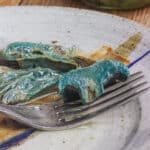
Jim Edelstein
Thank you Alan! I wish I could post pics here, the processing of these mushrooms is beautiful. Hope you come out with a book on mushrooms one day. You never let us down when we find something new.
Alan Bergo
Thanks Jim. Yes it's taken me much longer to start putting the pieces of the mushroom book together, partly because it is extremely expensive for me to produce and not a real source of revenue. The silver lining is that I've been collecting many new species than I anticipated. This year alone I probably added 5 new varieties I wouldn't have thought I could cover previously. It'll be worth the wait.
Miles
What knife is that? it looks awesome
Alan Bergo
Puma knives.
Tor
So I want to pressure can these for shelf life.
But can I use 1 full
Cup olive oil as we don’t cook with the other oils.
Also safe to pressure can jars with oil?
I think I will leave out the Chili as I love the earthy unique taste of the indigo..☺️
Alan Bergo
You'll be fine water batch canning these, just make absolutely sure everything is completely underneath oil. I think a waterbath would be fine, I haven't tried pressure canning these, but you likely could. I would leave in the chili, it's not going to overpower the mushrooms. Your choice though. Generally preserves like this I refrigerate.
Tor
Thanks so much. Being I want to shelf these and low acid, I probably have to pressure can to be safe. Though water bath is so much faster. But we have so many little ones and just want to play safe. I have just never pressure canned oil.
So I can use a full cup of Olive oil?? Rather than another oil?
Thanks I will likely keep the chilli flakes.
Also thinking of drying some like you said.
Love the idea of homemade pasta in broth.
With homesteading and 14 kids we like to make our own food and that includes pasta with fresh ground grain and my middle aged kids love experimenting with new exotic flavours. They are not scared to try anything.
Cammy freed
Hi,
Fantastic recipe! Thank you for sharing this. I have just one question.
How long will the mushrooms usually keep after canning? I boiled my cans and lids prior to adding mushrooms and olio.
Thanks!
Cammy.
Alan Bergo
Well the mushrooms haven't been canned per se, this is more like a refrigerator pickle, although they are blanched in a shelf stable liquid with a PH lower than 4.2 which is industry standard for water bath canning. They're not held in the liquid though, they're held in oil. Giardiniera is often canned like this, but it's often done commercially in pressure canning methods that bring the internal temperature above 220 F, which makes things shelf stable without a low PH. Long story short, I would use them within a month or two, if you see white mold spots on the mushrooms, it's time to throw them out. The less air in the containers, the better too, and it's important that the mushrooms are always completely covered with oil to keep them away from bacteria. I may have to ammend the post, thanks.
Jeremy
could you pressure can with this recipe without ruining the flavor/texture? My refrigerator space is precious these days.
Thanks for the recipe!
Jeremy
Alan Bergo
Absolutely.
pete hautman
It may be that the acid in the pickling liquid is what preserves the blue color, much the same way that adding a little lemon juice or vinegar to a purple cabbage sauté preserves the blue/red color. In any case, I love this idea, and if we ever have another L. indigo year like this one was, I'll be giving it a try! Thanks for the post (and for all your others.)
Alan Bergo
Pete, I've been doing experiments with more of them. It is indeed the acid that preserves the color. Your comment helped me pin point that. Thank you.